Learning about welding is essential for anyone who wants to venture into metalwork or engineering. If you’re interested in becoming a welder, you may have already learned that there are various types of welding techniques. Butt welding is one of the most popular methods among welders. It involves joining two pieces of metal together by heating until they melt and flow together. But did you know that there are different types of butt welds? In this blog post, we’ll explore the various types of butt joint welds and their uses.
Square Butt Joint Welds –
The square butt joint is the most common and straightforward type of butt joint weld. It requires the end of two metal pieces to be squared and fused. This type of joint is ideal for flat surfaces as it provides maximum strength and stability. Square butt joints are mostly used for construction projects, shipbuilding, and general metal fabrication.
V Butt Joint Welds –
The V butt joint weld follows the same principles as the square butt joint. However, instead of squaring the edges, the metal pieces are bevelled to create a V-shape groove, providing more surface area for welding. This type of joint is stronger than square butt joint welds as it penetrates deeper into the material, making it ideal for thicker metal sheets. V butt joint welds are mostly used in the manufacturing of automobile frames, heavy machinery, and structures subjected to high-stress loads.
U Butt Joint Welds –
The U butt joint is formed when the two metal pieces are joined with a U-shape groove, creating a ‘U’ channel. It provides better penetration than square butt joints and requires less material removal than the V butt joint weld. U butt joint welds are mostly used in the manufacturing of pipelines, storage tanks, and pressure vessels.
J Butt Joint Welds –
The J butt joint weld is created by shaping one edge into a J shape and joining it with another piece of metal. This type of joint is weaker than others and should only be used for light-duty applications. J butt joint welds are commonly used in the manufacturing of ornamental ironwork and light-duty metalwork.
Double Butt Joint Welds –
This type of butt joint weld is used when two pieces of metal are fused on both sides. It provides superior strength and is commonly used in heavy-duty and high-stress applications such as bridges, beams, and machine parts.
Conclusion:
In conclusion, understanding the different types of butt joint welds and their uses is essential knowledge for any metalworker or welder. Each joint type has its advantages and limitations, and selecting the right one depends on the project requirements. By considering the thickness of the metal sheets, the strength required, and the type of application, you can determine which type of butt joint weld is best suited for your project needs. Welding requires patience, skill, and the right tools and equipment. Therefore, training and equipping yourself appropriately to achieve the desired results and complete your project safely and efficiently is vital.




